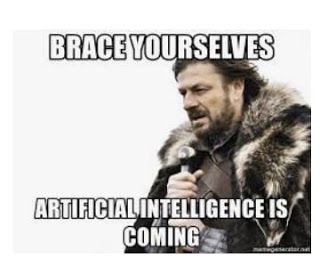AI: 4th Industrial Revolution
- Blog Buddies
- Jan 24, 2021
- 3 min read
Updated: Jun 3, 2021
Some call artificial intelligence the fourth industrial revolution - and it fascinates us, and our mind raises many questions about the same as it's a huge thing. It is a fascinating thing, but somewhere it scares us a little. (I’m still not sure I want to be on the same roads as self-driving cars!) But we cannot deny that AI has made our lives so much easier than ever before, and it is much more than what we must have imagined.

As you are reading about AI, you tend to think about how it actually comes into use in your daily lives, and you must be trying to relate it somewhere or the other way. Therefore, such examples can be
virtual assistants or chatbots - e.g., Siri or Cortana
smartphones that identify us through fingerprint or facial recognition
cars that can detect pedestrians and park themselves (often better than humans do).
We also think about computers that recognize and analyze documents automatically.

AI is also widely present in the business environment. The following pieces of evidence can explain this:
HR departments that more efficiently optimize a selection process;
Quality assurance departments anticipating and even preventing problems before they may occur; and,
Marketers who predict customers’ needs and optimize interactions between brands and consumers.
And AI is also super active in the finance field and also for accounting departments specifically.
As an accounting professional, you might wonder how these technologies will help an accounting profession and impact finance functions and workflows, what transformations can be predicted, and how this technology will shape tomorrow’s finance department.
Recent industry reports have explored the positive implications of AI on accounting teams and confirm that AI and associated natural language interfaces can change how the finance and accounting teams and other stakeholders interact with data. In fact, finance leaders play a key role in bringing emerging technologies such as AI to business.
A Case Study in Accounts Payable :

The concept, automating accounts payable processes has first surfaced about 20 years ago. The earlier solutions had nothing to do with the current approaches, especially performance and reliability. But they did have a similar objective, i.e., Automate a tedious and repetitive process to make AP personnel's lives easier and optimize the efficiency of the finance processes.
Before AI's existence, the processing of invoices, purchase orders, or delivery orders on paper documents was created by the accounting teams manually. Later these documents were manually entered into the computer systems, coded, and finally transmitted for the manager's approval and payment. But today, because of AI, there are no more manual processes! AP's workflow process is automated by the software that analyzes, recognizes, directs and exports data into a company's ERP or financial system. Also, before the automation, AP workflow, suppliers had little insight into the payment timing details, but now they have full access to all these details and information in real-time. Investment in Artificial Intelligence:

The usage of artificial intelligence has a positive impact on the finance department of AP solutions. The maturity, reality and industrialization of intelligent AP automation solutions are leveraging AI to create business models which are now also accessible to the small and medium-sized market. But before AI, they are only accessible to enterprise firms.
To manage documents automatically with variable structure, such as invoices, algorithms have become more and more reliable, flexible and adaptable. Therefore, without any prior configuration, the data is automatically recognized exhaustively and reliably.
Millions of users have access to Cloud solutions, which results in constant technological enhancements. The machine learning capabilities of cloud-based software solutions are constantly improving. These solutions do not make the same mistake again once humans correct them. So basically, these solutions learn from their mistakes.
And using AI in financial and accounting systems is leading to real profits. As experienced human AI-driven AP automation solutions can learn as fast and as accurately to:
Identify and interact with suppliers;
Automatically intake, code, process and route invoices, using optical recognition technology; and,
Denote payment deadlines, approval workflows, and approvers.
Bryan Schmidt, the controller for Unite Here Health and a cloud AP automation user, said, “What used to take weeks now only takes about two and a half days". “The improvements are due to capturing, automatically coding and storing invoices instead of handling paper or sending around PDF files. The system observes and learns from clerks’ keystrokes, continuously improves GL coding, and reduces errors.”

A positive transition will be noticed by finance teams from a task-driven approach to one of empowerment in which AI-driven systems are now in charge of low-value repetitive tasks - data entry, referrals, verifications and fraud detection - and employees are freed to produce real added value with time for analysis, strategy, creative thinking, and decision-making.
Given the spectacular progress of AI, this new world will be familiar to you long before a self-driving mail truck drops the last paper invoices in the office.
Until next time, you know the drill...
Like, comment, share and subscribe.
Previous article: AI: An Opportunity, Not a Threat for your Accounting Firm






Comments